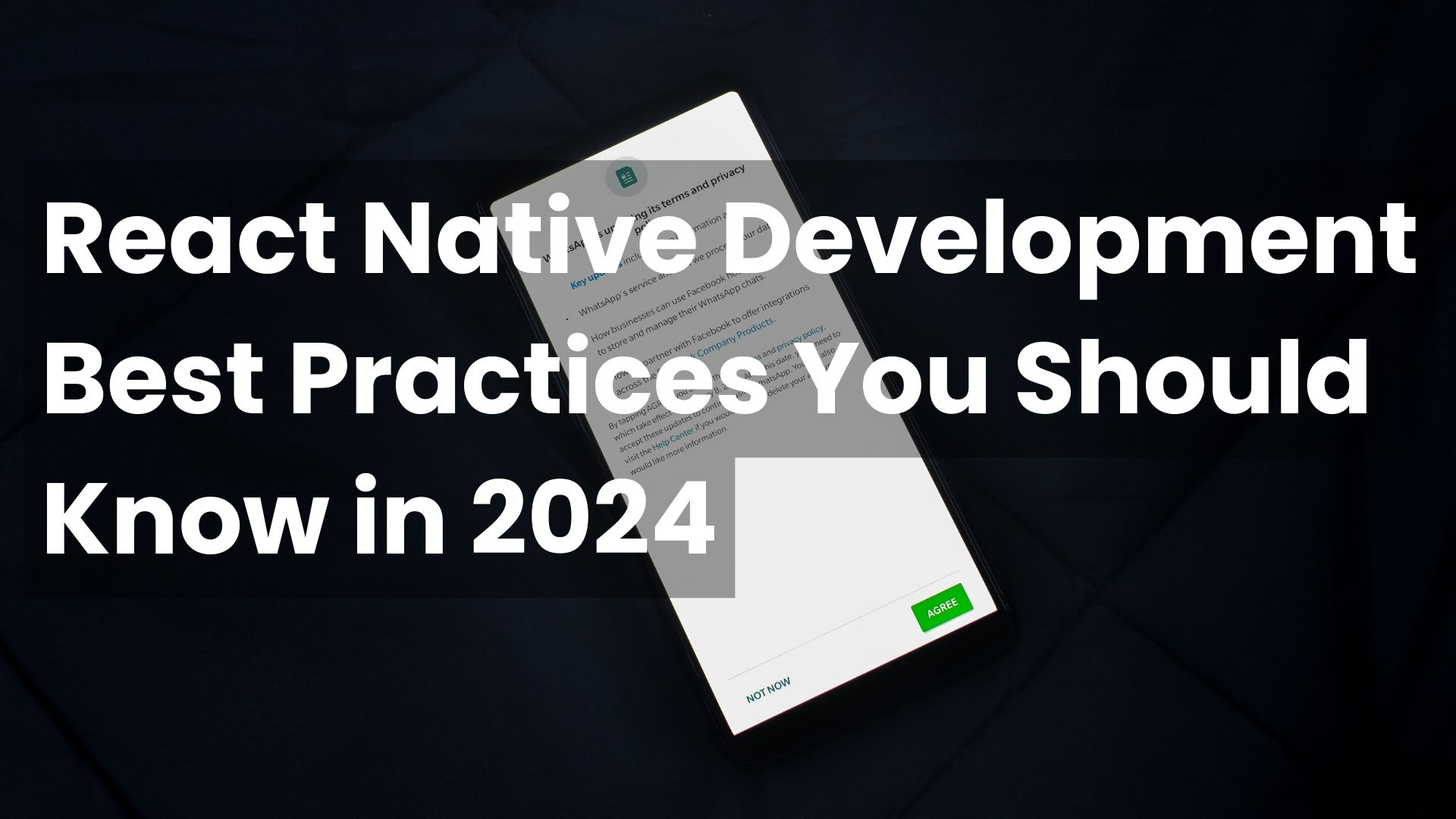React Native Development Best Practices You Should Know in 2024
 Anurag Singh
Anurag SinghTable of contents
- You should carefully plan your app architecture.
- Optimize Your Code for Performance
- Prioritize Accessibility
- Implement Offline Caching
- Keep Dependents in Mind
- Implement Robust Navigation
- Write Maintainable Code
- You Should Test Your App Often
- Images and Media Optimization
- Useful Analyses
- Onboarding is a great experience.
- Why Hire React Native developers in the USA?

React Native is one of the most popular frameworks to build cross-platform mobile applications. React Native is a framework that makes mobile development more efficient and faster by leveraging React. Here are some best practices for building React Native applications as we approach 2024:
You should carefully plan your app architecture.
Take the time to plan out your app's architecture and structure before you begin development. Consider how components will be connected and shared data. Planning will help development run smoothly. Consider these things:
Choose which data can be shared between platforms and which cannot.
Structure your components logically and consistently.
Implement global state management using Redux or MobX.
Leverage React Native's native modules for device API access.
React Native apps that are scalable and maintainable require a good architecture.
Optimize Your Code for Performance
Mobile apps must perform well. React Native offers many options for optimizing your code to run efficiently on devices. Here are some tips.
Find slow areas using the Profiler tool.
Code splitting is used to load modules lazily.
Be cautious with complex views and nested views.
When possible, cache network requests.
When appropriate, render hidden components null.
If you are animating style properties, use the native driver.
Test the performance of your target devices regularly and make any necessary adjustments. Smooth interfaces make users happy.
Prioritize Accessibility
It is important to ensure that your app reaches the largest audience possible. When using React Native, you should:
Add accessibility properties such as accessibilityLabel and accessible.
Colours and contrast should be accessible.
Support screen readers by using the correct ARIA roles.
Test your app using VoiceOver for iOS or TalkBack for Android.
Text can be scaled without breaking the layout.
Your app should be accessible to everyone.
Implement Offline Caching
Users of mobile devices may not always be able to connect to the internet. Offline support increases reliability.
Add a check for connectivity to detect the offline status.
AsyncStorage and Realm allow you to store data locally.
Cache network request results.
Sync actions in the queue when the connection is restored.
Handle offline states gracefully in the UI.
Offline usage allows your app to work anywhere, anytime.
Keep Dependents in Mind
React Native's ecosystem is constantly growing. It is important to manage dependencies correctly.
Remove any dependencies that you no longer need.
Be on the lookout for packages that are outdated and have security issues.
App size and imported features should be balanced.
Avoid relying on too many external software packages.
Test integrations thoroughly after updating dependencies.
By being disciplined with dependencies, you can avoid headaches in the future.
Implement Robust Navigation
Apps must have a navigation structure that is intuitive and responsive. Navigation in React Native is as follows:
Choose a nautical library such as React Navigation or React Native Navigation.
Structure logical navigation flows.
Handle deep linking properly.
Animations of transitions between routes.
Header back buttons allow for easy context returns.
A good navigation system is essential for user retention and experience.
Write Maintainable Code
Apps need ongoing maintenance and updates. Here are some tips for maintainable code.
Components can be broken down into smaller pieces with a single function.
TypeScript is a great tool for type safety.
Reduce the complexity of layouts and styles.
Name your items consistently and clearly.
Comment carefully.
Use linting to make your home prettier.
Enable editor autocompletion.
It is much easier to maintain clean code.
You Should Test Your App Often
Test your app thoroughly before it is released:
Unit test utility and logic functions.
Snapshot test component render output.
Test component combinations for integration.
Automate UI testing with Detox.
Manually test all the flows.
Test your software on a variety of devices.
A good test can save you a lot of headaches!
Images and Media Optimization
Apps often need icons, videos and other media. To optimize them for React Native:
When possible, use SVGs instead of PNGs.
Compress JPEG files and PNG images.
Add image caching.
Reduce the resolution as much as possible.
Lazy load non-critical media.
Use smaller preview images and full size if needed.
Optimized media reduces the size of apps and speeds up loading.
Useful Analyses
Analyses provide valuable insights into the way people use your application. Be sure to:
Add error reporting and logging.
Keep track of key user flows, actions and behaviours.
Monitor performance metrics
Integrate analytics tools like Amplitude and Mixpanel.
Analyze data regularly and take action.
Analytics can guide product decisions.
Onboarding is a great experience.
Early user onboarding can be vital to adoption and retention. Consider:
Gradual onboarding vs. overloading up front. Data Exploration should be completed before signing up.
Simple options for authentication
Enhancement of your profile after registration.
Personalized messages and tips
Smooth onboarding reduces friction for new users.
Following these best practices will help you build React Native applications with a great user experience. You will benefit from paying attention to the details, such as performance, testing and maintainability. You can build iOS and Android apps efficiently by leveraging React Native.
What are the best practices you have found for React Native? Share your knowledge with the community!
Why Hire React Native developers in the USA?
Hiring React Native Developers in USA for your mobile app can offer significant advantages over hiring talent from overseas. Here are the top reasons you should hire React Native developers in USA.
Communication and Collaboration
You can benefit from the same time zone and cultural context when you work with US-based developers. It is crucial for the smooth communication of software projects. Direct team communication makes it easier to maintain ongoing collaboration.
Accountability and Ownership
In the US, developers are more accountable in their work. They are more responsible for delivering quality solutions on time. Your team is also able to provide greater oversight when they are nearby.
Talent and expertise
The US has a large pool of talented React Native developers. They have experience in various industries and companies of all sizes. Many hold computer science degrees from top universities. You can expect high levels of competency.
Legal Protection
Apps benefit from greater protection of intellectual property under US law. If issues arise, local legal recourses are more readily available. Privacy laws, such as GDPR and CCPA, are more closely followed.
Shared Context
US developers are already familiar with the nuances of the local market. Apps are built for US-centric ecosystems, such as the App Store. Shared cultural, social, and business contexts.
Travel and Coordination
Geographic proximity makes it easier to travel and collaborate with developers in the US. The shared time zones allow for more coordination. Travelling overseas can drain you.
Quality and Consistency
The US developers adhere to stricter quality standards and processes. They often adhere to proven SDLC practices. Overseas teams are usually more stable and mature.
Hiring talented React Native developers in the United States will allow you to build, launch, and scale mobile applications by leveraging their skill, accountability, and contextual expertise. Superior outcomes are achieved through strong communication and seamless collaboration. For your next mobile project, consider sourcing your React native team in USA.
Subscribe to my newsletter
Read articles from Anurag Singh directly inside your inbox. Subscribe to the newsletter, and don't miss out.
Written by
